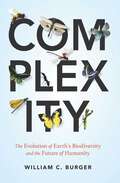- Table View
- List View
How I Played the Game: An Autobiography
by Byron NelsonByron Nelson was one of golf's greatest legends. He was one of the finest golfers ever to pick up a putter, and the man who had the most magnificent year any golfer has ever had—1945, when he won an incredible eighteen PGA tournaments, including eleven in a row, and finished second in seven others.How I Played the Game is the beautifully told tale, in his own words, of a man determined to be the best ever: his hardscrabble rural Texas upbringing and his near-death experience with typhoid fever; his early years as a caddie at Fort Worth's Glen Garden Country Club (where as a 15-year-old he beat another young caddie named Ben Hogan in the Caddie Championship); the lean years as an amateur and as a young pro during the Depression; and the golden years of the 1940s, when he invented the modern golf swing and forged the legend of "Lord Byron."Even after his sudden retirement (the real reason for which is finally revealed here) his impact on the game never lessened. Besides his many years as an insightful TV golf commentator, he was mentor to several future golf champions, Ken Venturi and Tom Watson among them. And he continued to play top-caliber golf with the greats of the game, like Hogan, Jack Nicklaus, and Arnold Palmer, and some who were less than great—President Eisenhower, Bing Crosby, Bob Hope, and a host of others.Laced throughout with scores of priceless stories, anecdotes, opinions, and even golf tips, and with an in-depth, event-by-event recreation of his golden year, 1945, How I Played the Game is golf writing and remembrance of the highest order—irresistible reading for every golfer and fan.
Robert E. Lee: A Life Portrait
by David J. EicherRobert E. Lee offers both a succinct biography and "the" definitive collection of photographs, important paintings, original engravings, artifacts, and significant documents pertaining to the Confederate general. Although the Civil War years are emphasized, Lee's early years, the Mexican War, and the postwar years in Lexington are amply explored.
The Spare-Time Gardener: Tips and Tricks for Those on the Go
by Barbara Hill FreemanOffering tips on finding your own gardening style, choosing climate-appropriate plants, creating low-maintenance landscaping and hardscaping, and weeding efficiently and effectively, Freeman understands that there's no room for scolding, but there is a real need for encouragement and good humor.
Think Before You Like: Social Media's Effect on the Brain and the Tools You Need to Navigate Your Newsfeed
by Guy P. HarrisonAt a time when the news cycle turns on a tweet, journalism gets confused with opinion, and facts are treated as negotiable information, applying critical thinking skills to your social media consumption is more important than ever. Guy P. Harrison, an upbeat advocate of scientific literacy and positive skepticism, demonstrates how critical thinking can enhance the benefits of social media while giving users the skills to guard against its dangers. Social media has more than two billion users and continues to grow. Its widespread appeal as a means of staying in touch with friends and keeping up with daily news masks some serious pitfalls-- misinformation, pseudoscience, fraud, propaganda, and irrational beliefs, for example, presented in an attractive, easy-to-share form. This book will teach you how to resist the psychological and behavioral manipulation of social media and avoid the mistakes that millions have already made and now regret. Harrison presents scientific studies that show why your subconscious mind loves social media and how that can work against your ability to critically evaluate information. Among other things, social media reinforces your biases, clouds your judgment with images that leave a false impression, and fills your brain with anecdotes that become cheap substitutes for objective data. The very nature of the technology keeps you in a bubble; by tracking your preferences it sends only filtered newsfeeds, so that you rarely see anything that might challenge your set notions. Harrison explores the implications of having digital "friends" and the effects on mood, self-esteem, and the cultivation of friendship in the real world. He discusses how social media affects attention spans and the ability to consider issues in depth. And he suggests ways to protect yourself against privacy invasion, cyberstalking, biased misinformation, catfishing, trolls, misuse of photos, and the confusion over fake news versus credible journalism.
Nature's Virus Killers
by Mark StenglerThis book arms you and your family with weapons to defeat health-stealing viruses such as cold, flu, hepatitis, Epstein-Barr, herpes, and a platoon of others.
Great Calculations: A Surprising Look Behind 50 Scientific Inquiries
by Colin PaskScience is based not only on observation and experiment, but on theory as well. As Einstein said, "Theory tells us what to measure." And theories are often crystallized into succinct calculations, like those made using Einstein's famous E = mc2. This book looks at fifty such great calculations, exploring how and why they were developed and assessing their impact on the history of science. As the author shows, many significant scientific calculations are quite simple and fairly easy to understand, even for readers will little math background. But their implications can be surprising and profound. For example, what links a famous comet and the cost of an annuity? Why do scientists claim there is "dark matter" in the universe if it can't be observed? How does carbon-based life on Earth depend on a quirk of nuclear physics? The answer to each question is an illuminating calculation. This accessible, engaging book will help you understand these breakthroughs and how they changed our view of life and the world.
Chili From the Southwest: Fixin's, Flavors, and Folklore
by W.C. JamesonJameson's book combines the lore of chili with over 125 recipes organized by history, geography, fact, and folklore. His recipes reflect traditional and nontraditional ingredients and include wild game, seafood, and health and vegetarian varieties, as well as celebrity favorites. "The Ultimate Chili Cookbook" includes explanations of terms, ingredients, and techniques for a quality bowl of chili. He also lists the top 10 chili cookoffs which attract thousands of afficianados across the country and are prime outlets for author appearances and selling books. He plans to update all of this information, broaden the appeal beyond Texas, and expand the celebrity section.
More Makers of American Machinist's Tools: A Historical Directory of Makers and Their Tools
by Kenneth L. CopeHere is the much-anticipated sequel to the author's Makers of American Machinist's Tools and American Machinist's Tools: An Illustrated Directory of Patents, pioneering works on machinist s tools and their makers. These books together provide the most comprehensive historical directory ever of the machinist tool industry and its technology. This volume covers hundreds of additional makers. There is also new material on the Big Five makers, with several of their previously unknown tools. The research and illustrations in this, and Cope s earlier volumes, provide a truly unique and incomparable reference source for collectors, dealers and researchers.
The New Low Carb Way of Life: A Lifetime Program to Lose Weight and Radically Lower Cholesterol While Still Eating the Foods You Love, Including Chocolate
by Rob ThompsonThis book serves as a guide for the next generation of dieters who will be delighted to know that only certian carbohydrates are responsible for adding on the pounds and clogging up the arteries—and sugar is not one of them.
Because It's There: A Celebration of Mountaineering from 200 B.C. to Today
by Alan WeberMountains have long inspired the wit and daring of the world's most fascinating explorers. In this definitive collection of mountain lore, Alan Weber exhibits forty-three essays by artists and adventurers to whom climbing was more a mission than a sport. Beginning with the fabled tale of Hannibal's Roman invasion-men, horses, and elephants in tow-through the hitherto impassable Alps, the accounts progress to recent descriptions of high-peaks mountain climbing in Mount Everest and the formidable K-2. Included among the earlier pieces are Petrarcha's introspective journey to the Windy Mount; William Windham's exploration of Montenvers and the "Sea of Ice" in 1741; and English artist-critic John Ruskin's essay on mountain climate and culture. Literary masters portray the idyllic and imperfect aspects of mountain life: the restoration poet Andrew Marvell offers a hymn to the Barrow hills, while poems from Shelley, Lord Byron, and Matthew Arnold praise the natural beauty and fresh air of the mountain crags. Because It's There pays homage to the spiritual introspection and respect for nature engendered by the looming mountain ranges that have demarcated territories, protecting villages and cities from invasion. The explorations these mountains have inspired have tested human endurance and mental strength.Alan Weber is a research fellow of the Institute for European Studies at Cornell University and a CEMERS Associate Fellow at the State University of New York at Binghamton. He is the editor and author of Nineteenth Century Science: A Selection of Original Texts, and Women Almanac Writers (Forthcoming). A long-time member of the Penn State Outing and Cornell Outing Clubs, he has rock and ice-climbed in the Adirondacks, Green and Shawangunk Mountains, and Mount Rainier.
Treestand Strategies
by Gene WenselIn this book the Wensel brothers take you through all the whys, wheres, and how of hunting from a treestand.
Lighthouse Horrors
by Charles WaughStorm-swept, remote light stations—and the isolated souls who man the beacons—are the perfect inspirations for tales of suspense and horror. Lighthouse Horrors collects 17 of the best from such writers as Rudyard Kipling, Robert Bloch, Jack Vance, and Ray Bradbury. This is a book to save for a fogbound or rain-dark night. Once you've read these pages, you'll never look at a lighthouse in quite the same way again.
Captain Blood
by Rafael SabatiniPeter Blood, a physician and an English gentleman, becomes a pirate after suffering a grave injustice. Barely escaping the gallows after his arrest for treating wounded rebels—who were fighting the oppressive King James—Blood is enslaved on a Barbados plantation. He escapes to Tortuga and becomes the leader of a colony of buccaneers. This is a classic swashbuckler filled with swordplay and adventure.
The Egg White Cookbook: 75 Recipes for Nature's Perfect Food
by Margaret Blackstone Barbara LeopoldThe egg white is low in carbs, calories, and fat and contains almost all of the protein available in the egg. The 75 recipes cover every meal, also included are surprising uses,facts,and lore, about the incomparable egg.
The Forgotten Storm: The Great Tri-State Tornado of 1925
by Wallace AkinThe amazing true story of the deadliest tornado in American history, as told by a survivor.
Defeat Into Victory: Battling Japan in Burma and India, 1942-1945
by Field-Marshal Viscount SlimField Marshal Viscount Slim (1891-1970) led shattered British forces from Burma to India in one of the lesser-known but more nightmarish retreats of World War II. He then restored his army's fighting capabilities and morale with virtually no support from home and counterattacked. His army's slaughter of Japanese troops ultimately liberated India and Burma.The first edition of Defeat Into Victory , published in 1956, was an immediate sensation selling 20,000 copies within a few days. This is an updated version with a new introduction by David W. Hogan Jr.
The New Saturday Night at Moody's Diner
by Tim SampleTim Sample's humor is as much a Down East institution as the famous little restaurant that inspired the title story of his book.
A Field Guide to Common Texas Insects
by John A. Jackman Bastiaan M. DreesMeet the wild world of common Texas insects with this colorful and thorough introduction. Now you can identify that critter that just crawled under your bed or landed in your backyard. This extensive guide is packed with 384 color photos, thousands of facts and figures, and dozens of illustrations.
Stockton to Malone: The Rise of the Utah Jazz
by Roland LazenbyThis is the hardest working team in the NBA — the Utah Jazz. Led by iron men Karl Malone, John Stockton and coach Jerry Sloan. Go behind the scenes to reveal the unparalleled competitiveness of a collection of over-achieving players and their demanding coach, whose never-say-die efforts have captured the hearts of the entire state of Utah and basketball fans throughout North America.
Dave Whitlock's Guide to Aquatic Trout Foods
by Dave WhitlockThis outstanding guide is filled with scores of practical observations on all of the trout foods of importance to fly fishers. The chapters include: * Concepts of Imitation * Water * How Trout Feed * Mayflies * Stoneflies * Caddisflies * Midges and Crane Flies * Dragonflies and Damselflies * Crustaceans * Forage Fish * Leeches, Eels, and Similar Trout FoodsSuperb black-and-white illustrations throughout reinforce the techniques outlined in this book. A central full-color section includes size and color charts for mayflies, stoneflies, dragonflies, caddisflies, damselflies, crustaceans, and forage fish.
Complexity: The Evolution of Earth's Biodiversity and the Future of Humanity
by William C. BurgerThis very readable overview of natural history explores the dynamics that have made our planet so rich in biodiversity over time and supported the rise and dominance of our own species. Tracing the arc of evolutionary history, biologist William C. Burger shows that cooperation and symbiosis have played a critical role in the ever increasing complexity of life on earth. Life may have started from the evolution of cooperating organic molecules, which outpaced their noncooperating neighbors. A prime example of symbiosis was the early incorporation of mitochondria into the eukaryotic cell (through a process called "endosymbiosis"). This event gave these cells a powerful new source of energy. Later, cooperation was again key when millions to trillions of individual eukaryotic cells eventually came together to build the unitary structures of large plants and animals. And cooperation between individuals of the same species resulted in complex animal societies, such as ant colonies and bee hives. Turning to our own species, the author argues that our ability to cooperate, along with incessant inter-group conflict, has driven the advancement of cultures, the elaboration of our technologies, and made us the most "invasive" species on the planet. But our very success has now become a huge problem, as our world dominion threatens the future of the biosphere and confronts us with a very uncertain future. Thought-provoking and full of fascinating detail, this eloquently told story of life on earth and our place within it presents a grand perspective and raises many important questions.
And the Tide Comes In...: Exploring a Georgia Salt Marsh
by Merryl AlberThis book is a narrative told from the point of view of a young girl who is showing her visiting cousin a Georgia coastal salt marsh. The children visit the marsh every day for four days, slowly building their knowledge of the ecosystem. As they make their way through the tall marsh grass, the two children slip and slide on marsh mud, discover clusters of ribbed mussels at the base of the grass, and watch as fiddler crabs skitter from burrow to burrow around the edge of a creek. Representative of intertidal marshes throughout the world, the Georgia coastal salt marsh described in this book is typically shared by both land and marine mammals, presenting a unique ecosystem at the water's edge.
Murder, America: Homicide in the United States from the Revolution to the Present
by Jay Robert NashHere is a comprehensive collection of the most fascinating homicide cases in our nation's history. Jay Robert Nash brings the dark side of America to life in these briefs. Included are the most ingenious and the most notorious murders, perpetrated by a group of criminals of frightening and fascinating variety: Warren Waite, who tried to murder his way to an inheritance by spraying his mother-in-law with diphtheria, typhoid, and influenza germs; Arthur Perry, who committed the near perfect of his unsuspecting wife in 1938; and finally the vile maniac, John Wayne Gacy.Fortunately, many of these killers met their matches in brilliant and dedicated policemen, newspaper reporters, and even the occasional amateur detective. These are the heroes of history: the famed New York Inspector Thomas Brynes who cracked the most puzzling slayings of his day; the matronly Ethel Berman who relentlessly pursued her homicidal neighbor. And then there is that most bizarre case of the super-cop Robert John Erler, who, unbelievably worked on the cases of murders he himself committed.Examining the killings for every conceivable motive, Jay Robert Nash captures in his colorful prose all the strange, poignant, and terrifying facets of his endless intriguing subject. Through his exhaustive research and investigation, and with a remarkable collection of prints and photos, Nash has created the definitive exploration of this most dastardly of crimes.
My Arctic Journal: A Year among Ice-Fields and Eskimos
by Josephine PearyWife of self-proclaimed North Pole discoverer Robert Edwin Peary, Josephine Peary was the first woman apart from the Inuit to take part in an Arctic expedition. My Arctic Journal, unavailable for nearly a century, is Peary's memoir of the time she spent, from June of 1891 to August of 1892, accompanying her husband and his exploration party across the northernmost expanses of Greenland. Peary recounts in detail the hardships of life in the frozen North, and describes at length the customs of the Inuit natives, among whom she spent a great deal of time. She also tells of her experiences hunting near the top of the world, and gives her impressions of the other members of the expedition, who included explorers Dr. Frederick Cook and Matthew Henson. Richly illustrated and written with candor and emotion, My Arctic Journal is a unique gem of an exploration memoir.
Exploring Fort Worth With Children
by Michael S. BumaginCome to where the west begins! Fort Worth is a big city with a hometown heart and a YHowdy, neighbor? attitude. Visitors from all parts of the world and of all ages can find something here to interest and excite them. Take a look at some of the fun things to see and do in Cowtown USA: The StockyardsFort Worth ZooBass Performance HallCasa MananaTarantula TrainWater GardensKimbell Art MuseumAmon Carter MuseumTrinity ParkBotanic GardenSports and athletic eventsLibraries and bookstoresShopping mallsIce skating, bowling, golfLakes and parksHorseback riding and lots moreThis handy guide includes helpful information about cultural events, live theater and movies, churches, places to eat, places to stay, where to go for planning a party, emergency numbers, and day trips to surrounding areas. Michael Bumagin, M.D., is a Fort Worth plastic and reconstruction surgeon. He has been a docent at the Fort Worth Zoo and the Museum of Science and History.
























